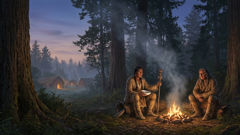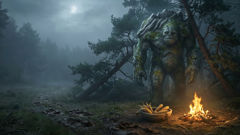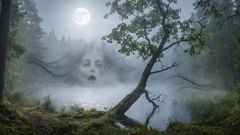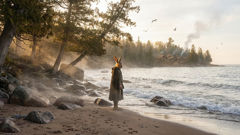Introduction
Wind sweeps across the thorny silhouettes of the Dragon's Blood Trees, umbrella-shaped sentinels that blot the sun and hold the island's oldest breath. Socotra isn’t merely a dot on a map; it is a living riddle, a place where resin glistens like dried blood and the sea keeps its own weather in the bones of the rocks. The island’s legends speak of D'jinn who drift between roots and wind, listening for the language of patience, listening for a heart brave enough to hear a truth not spoken aloud. If you stand at dawn and listen to the resin sigh, you might catch a whisper that travels from tree to shore to star, a message that—if you deserve it—a story will lend you a map that is less a chart of places and more a map of chances. Our traveler, a cartographer named Lamat, arrives with maps folded in brass clasps and a mind tuned for anomalies: places where a road ends in a scent, where a rumor becomes a rock, where a legend lingers in the resin of a tree. He seeks a thing as old as rumor itself: the moment when a djinn steps from a shadow and offers not wealth or fear but a choice that could bend a life toward listening rather than speaking. He will learn that the island’s wisdom is not told in speeches but in silences between the breaths of goats on the hillside, the cautious drift of a seabird’s wing, and the patient pause that follows a storm’s last wave. The island seems to tilt toward the sea as if to offer a doorway; and in that tilt, the stories tilt too—toward memory, mercy, and a courage that doesn't shout but waits until it can be heard. Lamat’s journey will not be hurried; Socotra does not rush its visitors. It teaches time to walk with you, and to remember that every map begins with a listening ear and ends with a spark you can't draw on paper alone.
The Dragon's Blood Tree and the First D'jinn
The road to understanding begins not with questions, but with listening. Lamat does not rush toward revelation; he sits under the domed crown of a dragon’s blood tree and lets the resin, sweet and sharp, sink into his skin and his breath. The Djinn comes not as a roar but as a murmur that slides gently across the air, as if the wind itself were reciting an old prayer in a dialect of sea salt and resin. The first D'jinn, old as the island’s basalt cliffs and twice as patient, appears not to summon fear but to invite curiosity. Its eyes, mirrors of the moon-tide, measure a person not by fear’s tremor but by the quiet that follows a truthful confession: the moment when a traveler admits he does not know and asks to learn. The Djinn asks a strange thing of him: to map a path with patience instead of ink, to chart a possibility rather than a thing that exists in the world. The forest listens—the puffs of dust in the sun-lit air, the distant cry of a seabird, the soft, almost unnoticeable creak of dried resin. Lamat learns to read these signs as if they were letters in a script older than the island itself. He learns that the island’s true geography is a memory of patience, and that the Dragon's Blood Trees have grown here to remind inhabitants and visitors alike that every root travels toward a water that may never return. In the following days, he records the island’s whispers in a notebook that isn’t used for weather forecasts or star charts but for stories that answer to the heart rather than the eye. The first D'jinn teaches him the art of discernment: not every whisper is a call to come closer; some whispers warn you to stay still and listen longer. In that listening, Lamat begins to understand a truth that will recur like a refrain: wisdom is a thing you earn by staying rather than fleeing, by letting fear cool into curiosity, and by offering something back to the island that first spoke to you—your own listening.
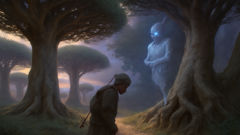
The Pact Beneath the Dragon's Blood
The story deepens when the second Djinn arrives, not as a single figure but as a shifting chorus of shadows that move with the leaves. This D'jinn is younger, but older than the first, a being that embodies the island's memory of storms and droughts. It speaks in a language that sounds like rain on the resinous bark, like the sigh of a boat that has weathered a long voyage. It asks for a bargain not of gold, but of stories. It tells Lamat that true maps are not drawn with ink alone but with memory: the memory of a place held in the body, remembered by the heart that has learned to wait. The bargain is delicate; it requires Lamat to walk away from certainty for a while, to let the world thin itself into questions rather than answers. In exchange, the Djinn offers him a gift: a way to see the island’s future through its oldest winter—the moment when seeds begin to sleep and the tree reclaims the ground for regeneration. They walk together through a grove where resin sparkles like broken amber, where the air smells of rain long promised but never delivered. The Djinn teaches him to listen not just to the wind but to the silence between two breaths. In those silences, the traveler learns to sense the presence of water; to hear the sea receding and returning; to recognize a signal carried by a feather’s fall and by the tremor of a tree’s umbrella-like canopy. The island reveals its most fragile beauty in this exchange: a pact that binds memory to action, a promise that the future will be more legible if one keeps the heart open and the ear tuned to the quiet. When at last Lamat writes the two journeys onto the same page, he discovers that the island’s geography is less a line on a map and more a rhythm—one that requires humility, endurance, and a willingness to become small in the presence of something immeasurably ancient.
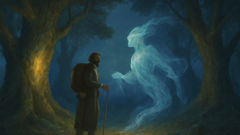
Conclusion
In the end, the island does more than yield a map or a secret; it offers a cadence for living with wisdom. Lamat leaves Socotra not with a compass but with a listening heart, with a memory that turns every ordinary day into a potential dawn. He learns that the true treasure is not control over the island’s weather or its stories, but the humility to inhabit uncertainty with patience. The D'jinn don’t vanish as soon as the traveler steps back onto the ferry; they become a part of him, a reminder that wonder isn't a possession but a practice. When one returns to the world, the resin on the skin remains as a faint, sweet sting, the wind still sounds like a language one could learn if one is willing to listen long enough. And so the tale travels on, from lips to pages to seashells, not to be owned but to be passed along to those who stand on a shore with the courage to hear what the island has kept hidden for so long: that wisdom, like Socotra’s trees, grows slowly, and the most faithful records are the ones etched in listening, patience, and a single, generous heart.








